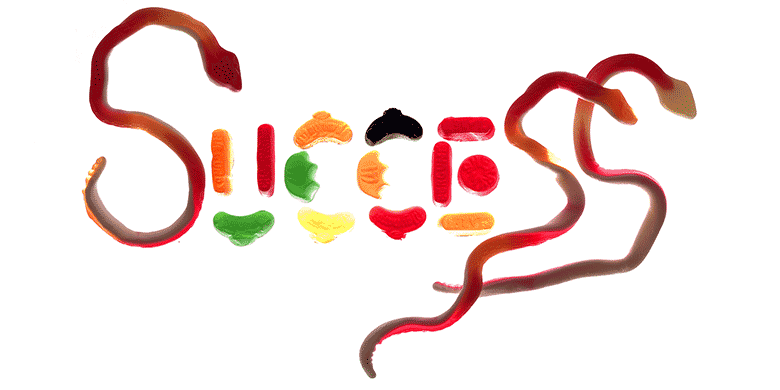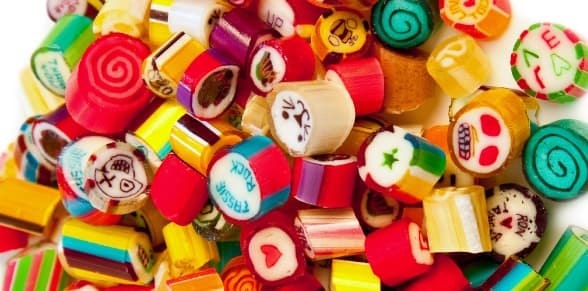
24 January, 2024
Sweet Success: Using Promotional Confectionery to Boost Your Brand
Traditional marketing methods like promotional confectionery can often be overlooked in a world of constant digital bombardment. However, as any seasoned marketer knows, the simple allure of a sweet treat can often achieve what complex marketing strategies might miss. See how promotional confectionery can elevate your brand, drive customer engagement, and offer a tangible ROI.
The Psychological Power of Sweets

Understanding the psychological impact of sweets can give your marketing efforts a unique advantage. Confectionery holds a special place in the human psyche for various reasons, making it a powerful tool to forge emotional connections with your audience.
1) Childhood Nostalgia
Sweets often evoke strong memories of childhood — a time generally associated with carefreeness, security, and happiness. Brands that successfully tap into this nostalgia can instil comfort and trust in their customers. Your brand will likely be remembered and favoured when it is aligned with such evocative emotions.
2) Festive Occasions and Celebrations
It is commonly featured in celebratory events, whether it's a birthday, a wedding, or festive holidays like Christmas or Diwali. These are times of joy, family togetherness, and overall positivity. By associating your brand with these happy moments, you're not just giving away a product but sharing in a universal experience. It's a potent way to create a deeper emotional link with your audience.
3) Reward Mechanism
They are often seen as rewards, whether it’s a parent offering a child a sweet for good behaviour or an adult indulging after a hard day's work. When your brand provides that 'reward,' you create a positive reinforcement loop that can prompt repeated engagement with your brand.
4) The Comfort Factor
They have been proven to release endorphins, the body's natural feel-good chemicals. This is often referred to as 'comfort eating' and while it has its health caveats, from a marketing perspective, it’s golden. Offering a sweet treat can instantly improve someone’s mood, and if your brand is the source of this comfort, it fosters a positive association.
5) Sensory Experience
The taste, texture, and even the aroma of confectionery engage multiple senses, making the experience more memorable. Brands can take advantage of this by paying close attention to the sensory profile of the confectionery they choose for promotional purposes. The goal is to create a holistic experience that lingers long after the treat is consumed.
6) Leveraging Scarcity
Limited-edition confectionery plays into the psychological principle of scarcity, making the product more desirable because it’s rare or available for a limited time. This can create a buzz around your brand and amplify its perceived value.
By comprehensively understanding confectionery's multifaceted psychological influences on individuals, brands can harness this power to forge meaningful, long-lasting relationships with their audience. This goes far beyond a mere transactional exchange, establishing a more profound emotional connection that can yield loyal customers.
Targeting a Wide Demographic

Its use is exceptionally versatile when it comes to demographic targeting. It has an innate ability to bridge gaps between age groups, cultural backgrounds, and even gender, making it one of the most universally accepted and enjoyed items for promotional activities. Below are some points that delve deeper into the vast demographic reach of confectionery and lollies.
1) Ageless Appeal
From children to grandparents, it appeals to all age groups. Younger people may be drawn to vibrant, sugary treats, while older adults might appreciate a classic flavour or even a sugar-free option. Either way, the age range it can attract is far wider than most other promotional items. Thus, when you invest in promotional confectionery, you're effectively targeting multiple generations simultaneously, thereby maximising your reach.
2) Gender-Neutral
Confectionery transcends gender norms and stereotypes. Sweets are universally beloved, whether it's chocolates, hard candies, or baked goods. This is particularly beneficial for brands that aim for an inclusive marketing strategy that appeals to all genders equally.
3) Cross-Cultural Charm
They are a global phenomenon, enjoyed in nearly every culture worldwide. Whether it’s a traditional sweetmeat or an internationally recognised brand, the language of sweetness is universally understood. This makes it a versatile tool for global campaigns or brands looking to diversify their customer base.
4) Dietary Considerations
With the increasing awareness around dietary needs and lifestyle choices, brands can offer a range that caters to various preferences — gluten-free, vegan, sugar-free, etc. This inclusive approach ensures you don't alienate any specific groups and cover a broader range of potential customers.
5) Emotional Resonance Across Groups
Emotions like joy, nostalgia, and comfort are universal, cutting across demographic boundaries. When you associate your brand with these feelings through sweets, you create a universally relatable emotional bond.
6) Easy Customisation
They can be easily customised to cater to a specific demographic if needed. Whether it's packaging that appeals to a younger audience or sophisticated presentation for corporate gifting, the sky is the limit.
Customisation for Better Engagement

One of the most potent features is its immense scope for customisation. This customisability adds a unique flavour and serves as a strategic avenue to establish a deeper connection with your target audience.
1) Shape and Form
The malleability of ingredients like chocolate allows them to be shaped into forms representing your brand or products. For instance, a car dealership could have chocolates moulded into the shape of cars, while a tech company could opt for gadgets or logo-shaped treats. This form of visual symbolism can make a lasting impression on the consumer's mind, associating your brand with a delightful sensory experience.
2) Wrapper Wonders
The packaging or wrapper can be a canvas for your brand's messaging. The wrapper can communicate various information from brand logos to taglines or even quick facts about your company. Some companies even go a step further by including QR codes that lead to promotional videos or special offers, turning the sweet treat into an interactive brand experience.
3) Flavour Profiles
Flavours can also be customised to reflect brand identity or seasonal themes. Imagine a coffee company promoting a new range of brews through coffee-flavoured sweets or a health and wellness brand opting for natural, fruit-based treats. Customised flavours can speak volumes about your brand's focus and area of expertise, fostering a deeper engagement level.
4) Sensory Engagement
In addition to taste and sight, other senses like smell and texture can also be played with. Scented wrappers, velvety chocolate textures, or popping candies that crackle in the mouth can offer a multi-sensory experience that's likely to be remembered long after the sweet is consumed.
5) Seasonal or Event-Based Customisation
Aligning them with holidays, seasons, or specific events adds a layer of topical relevance. Be it Christmas-themed gingerbread cookies or heart-shaped chocolates for Valentine’s Day, event-centric customisation can give your brand a timely and relatable context.
6) Ethical and Lifestyle Messaging
In an era where ethical considerations are front and centre, opting for eco-friendly packaging or sustainably sourced ingredients can send a strong message about your brand's values. This aligns particularly well with a younger, more environmentally conscious demographic.
Versatility in Marketing Channels

Their efficacy is not confined to its universal appeal or the boundless opportunities for customisation. One of its standout features is its adaptability across various marketing channels, making it an incredibly versatile tool in your promotional arsenal.
1) Trade Shows and Events
One of the most conventional yet effective ways to use them is at trade shows, expos, and corporate events. Here, the immediacy of the giveaway makes it a crowd-puller, drawing people to your booth and serving as an ice-breaker for further engagement. The tactile, physical experience of receiving and consuming a sweet treat can help forge a memorable connection, increasing the likelihood of post-event interactions or follow-ups.
2) Corporate Gift Baskets
When curating corporate gift baskets for partners, clients, or even stakeholders, including customised sweets can add a delightful touch. It serves as an unspoken gesture of goodwill and appreciation, setting the tone for a congenial business relationship. More importantly, unlike a standard corporate brochure or pen, the sweets are likely to be shared and enjoyed, expanding the reach of your branding within an organisation subtly yet effectively.
3) Employee Appreciation
Using them as tokens of recognition or rewards for employees underscores a sense of inclusivity and appreciation within the workplace. It’s not just a simple perk but a morale booster that can positively influence company culture. It also promotes internal brand loyalty, turning your workforce into brand advocates in a very organic manner.
4) Online Campaigns
You might think they are limited to physical interactions but they can also be integrated into digital marketing efforts. For instance, limited-edition promotional sweets can be announced on social media platforms or mailed to select customers as part of an online loyalty programme. The unboxing of these treats can become a social media moment, encouraging user-generated content that adds a layer of authenticity to your brand.
5) Direct Mail Marketing
Direct mail might seem like an outdated channel, but the impact can be significant when a delicious sweet treat is involved. It disrupts the norm of receiving bills and official correspondence, offering a pleasant surprise that is likely to capture attention and prompt further action, like visiting a website or availing a special offer.
6) Pop-Up Shops and Collaborations
Their versatility extends to retail collaborations or pop-up events. Products that align with the theme or collaboration can provide an extra layer of engagement, creating a memorable consumer experience that transcends the event.
7) Limited-Time Offers
Special, limited-time offers can create urgency and exclusivity around your brand, making them an excellent tactic for short-term customer engagement or sales boosts.
Calculating ROI: Not Just Sugar and Spice

It may seem like a whimsical investment, sprinkled more with sentiment than strategy. However, the ability to measure its return on investment (ROI) is far from nebulous. Beneath the sugar-coated exterior lies a powerful marketing mechanism that can yield quantifiable benefits.
1) Social Media Amplification
One immediate and easily measurable aspect of ROI is social media engagement. Its allure often prompts recipients to share their 'sweet experience' online. This act of digital word-of-mouth can amplify brand exposure exponentially. By tracking metrics like reach, engagement rates, and conversions generated from these user-generated posts, you can assess the tangible impact of your confectionery campaign.
2) Conversation Starters and Lead Generation
They can serve as conversation starters at events or within a retail setting. The positive emotions generated by receiving a free treat create a conducive environment for your sales team to initiate a dialogue with potential clients. The leads thus generated can be tracked as they move through the sales funnel. Metrics to consider include the conversion rate of these leads, the average deal size, and the speed at which these leads convert, all directly contributing to your ROI calculation.
3) Customer Retention
It can also be used as part of a customer retention strategy. The cost of retaining an existing customer is generally lower than acquiring a new one. By measuring the change in retention rates after implementing a confectionery-based loyalty programme, you can evaluate the ROI through increased customer lifetime value and reduced churn rate.
4) Brand Recall and Future Engagements
The intangible benefits of brand enhancement and recall also contribute to ROI, albeit less directly. Customers who receive it are more likely to remember the brand positively and are more inclined to future engagements. This improved perception can be measured through brand tracking surveys and can manifest in increased sales over the long term.
5) Data-Driven Customisation
Another metric to consider is the amount of customer data collected through customised promotions. For instance, QR codes or website URLs on sweet wrappers can direct recipients to a landing page where you can capture information. The value of this data in augmenting your customer database and enabling more targeted future campaigns also contributes to ROI.
6) Budget and Cost-per-Impression
Finally, the financial aspect: the budget. To truly measure ROI, you must compare the benefits reaped against the expenditure. One common metric here is cost-per-impression, assessing how much each instance of brand exposure costs you in the context of the promotional sweets. This helps you quantify the 'value for money' of your confectionery marketing in direct financial terms.
By considering these multifaceted aspects, you can derive a more nuanced understanding of the ROI from your promotional confectionery. Far from being mere tokens of goodwill, these sweet treats can be strategic assets in your marketing arsenal, replete with measurable financial and brand-related gains.
Analytics and Tracking

Though they may be given away with a smile and a nod, these items can actually serve as strategic elements in a broader marketing plan. The challenge lies in quantifying their effectiveness, especially in an age where digital analytics offer real-time insights for most marketing activities. Fortunately, tracking and analytics are possible even with something as tactile and traditional as confectionery.
1) Redeemable Coupons
Redeemable coupons are one of the most direct methods to track effectiveness. By attaching a coupon to the sweet wrappers, you can encourage the recipients to redeem them later, either online or in-store. This serves two purposes: it extends the customer's interaction with your brand and provides you with a measurable action that can be directly attributed to the confectionery campaign. When compared to the total distributed, the number of coupons redeemed gives you a clear redemption rate, offering insights into engagement and efficacy.
2) QR Codes and Landing Pages
Another modern approach involves integrating QR codes into the packaging. When scanned, these codes can direct the user to a landing page designed specifically for the campaign. This landing page can serve multiple purposes — capturing customer data and offering exclusive promotions. It can even be tailored to ask for feedback on the item itself. The metrics from this landing page, such as visitor numbers, dwell time, and conversion rates, can be directly attributed to the effectiveness of your confectionery campaign.
3) Geo-Tracking and Event-based Analysis
Geo-tracking can be used to measure engagement if they are distributed at an event or specific location. Tracking the footfall before, during, and after the event can provide valuable insights into whether the they led to increased engagement or extended dwell time. Additionally, you can measure the campaign's success by comparing customer engagement metrics with those of similar events where it was not distributed.
4) Customer Surveys and Feedback
While more qualitative in nature, customer surveys and feedback forms provide valuable insights. Was the brand message clear? Did it positively impact their perception of the brand? These answers can be analysed to measure the intangible aspects of customer engagement and sentiment, which, in turn, can be correlated with brand loyalty and future sales.
5) Sales Data Correlation
Finally, looking at the bigger picture involves correlating sales data with the active promotion period. Increases in sales, particularly of products or services directly related to the campaign, can be a compelling indicator of ROI.
Conclusion
Promotional confectionery offers a unique blend of psychological impact, broad demographic appeal, and versatile marketing channels. While traditional in nature, it has modern applications that can generate tangible results. So, the next time you're pondering how to add a creative twist to your marketing campaign, consider confectionery's sweet, simple power to elevate your brand to new heights.
The Confectionery Only Team
